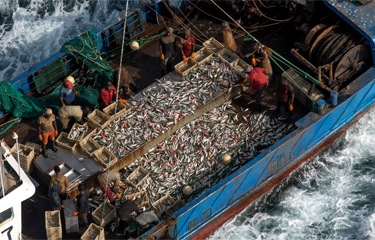There’s been a huge increase in the output and earnings of China’s distant-water fleet since 2010 – but the fast pace of the sector’s growth may be over.
A report on the sector from market research group Qianzhan reveals that while the output of China’s distant-water catch doubled from one million metric tons (MT) in 2010 to two million MT in 2014, the growth rate of the sector in 2020 had slowed to 6.8 percent and a total catch of 2.32 million MT. And in the 2019-2020 period, an “adjustment in the content” of the catch meant the value of the output from the sector fell by 1.8 percent year-over-year to CNY 23.9 billion (USD 3.8 billion, EUR 3.3 billion), Qianzhan said.
While the Qianzhan research report doesn’t spell out what the adjustment was, China’s expanding distant-water fleet has recently put more focus on squid. Data from China’s Agriculture Ministry data shows that squid (520,300 MT in 2020) and tuna (327,400 MT in 2020) now constitute the top two species in the catch – 22.5 percent and 14 percent of the 2020 catch total, respectively. China’s distant-water squid catch was worth CNY 26.2 billion (USD 4.2 billion, EUR 3.6 billion) in 2018, up from CNY 13.5 billion (USD 2.1 billion, EUR 1.8 billion) in 2012.
Along with higher catches, the percentage of China’s distant-water catch shipped back to China for domestic consumption has been rising. According to Qianzhan, 68 percent of the distant-water catch was shipped back to Chinese ports for domestic processing and sale in 2020, amounting to 1.57 million MT, versus 743,000 MT that was sold to foreign buyers.
“Because the cost of transporting the products back to China is high, the higher value catch has traditionally been sold to foreign buyers especially in Japan, the E.U., and U.S.A.” the Qianzhan report noted. But that has changed as China’s domestic demand for seafood – and particularly, high-value seafood – has risen.
The China Hotel Association, the biggest trade group representing China’s hotel industry, has predicted that seafood will continue to grow its share of protein consumption at the expense of pork in particular, putting the shift down to growing awareness of the nutritional value of seafood. The share of consumption held by beef, lamb, and pork has dropped back from 60 to 50 percent, according to the association, while the share held by seafood has increased from 23 percent to 30 percent.
Even with the growth of the sector, the financial performance of several of its key players has not been consistent. Though average seafood prices rose 9.1 percent year-on-year in China in the first three quarters of 2021, according to a survey of wholesale markets by the Agriculture Ministry, leading distant-water players have been stung by higher input costs and difficulty collecting payments.
Margins at Pingtan Marine are being squeezed by COVID-19-related restrictions and mounting bad debt, Pingtan Chairman and CEO Xinrong Zhuo told investors in an earnings statement. In 2020, the company struggled to overcome a trend of Chinese fish processors switching to domestic markets in the face of uncertain export demand and soaring freight costs. A resulting delay in payments hurt Pingtan’s pricing power on seafood supplied to those processors.
Even though the company’s revenue, at USD 36.1 million (EUR 32.1 million), increased by 133.7 percent through the first three quarters of 2021, its net income reached just USD 800,000 (EUR 710,000). Its average unit sale price in Q3 increased 11.4 percent, and over the first three quarters of 2021, the company’s average unit sale price increased 25.9 percent. However, the price increase was eaten up by soaring production costs, higher refueling costs, and higher prices paid for fish not caught by Pingtan’s own vessels. The company also endured higher fees for insurance, storage fees, and customs clearance charges, and suffered an increase of “bad debt expenses.” Yet Zhuo said the firm is optimistic about the long-term outlook.
“We are confident in the sustainable development of China's fishery industry,” Zhuo said. “We believe that for companies like Pingtan that focuses on pelagic fishery development, our advantages will become more apparent as the market gradually recovers."
China Ocean Group, a fishing and seafood-distribution firm with a large distant-water fleet, has also taken a earnings hit in 2021 due to the COVID-19 pandemic. Revenue at the Hong Kong-listed firm decreased by 41 percent year on year in the first half of the year to HKD 224.4 million (USD 29.1 million, EUR 24.1 million) – a drop the company attributed to the slowness in its fishing licenses being renewed by China’s Agriculture Ministry, a problem it attributed to difficulties ministry staff had in getting to international waters where the company’s vessels operate.
Stock research firm Simply Wall Street recently questioned the scale of salary paid to China Ocean CEO Liu Dongsheng – HKD 1.5 million (USD 195,000, EUR 165,000) in 2020 – as over the last three years, the company’s per share earnings have shrunk by an average annual rate of 118 percent. Its 2020 revenue was down 41 percent over 2019.
“It's hard to argue the company is firing on all cylinders, so shareholders might be averse to high CEO remuneration,” Simply Wall Street said.
To turn around the company’s fortunes, Dongsheng recently announced a planned expansion of the company’s distant-water fishing operations with the goal of increasing the share of its own catch sold via its distribution channels.
Photo courtesy of Pierre Gleizes/Greenpeace







